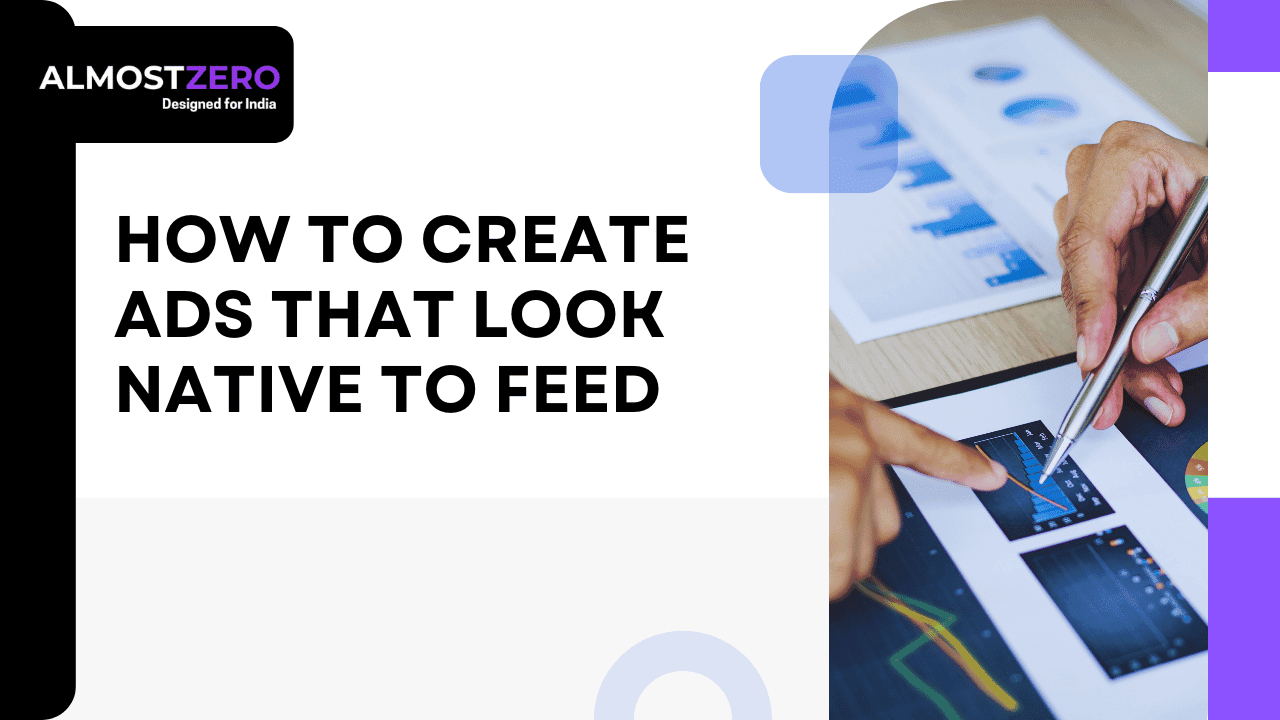How to Create Ads That Look Native to Feed

Think about the last time you scrolled through Instagram, Facebook, or LinkedIn. Did you stop for an ad—or did it feel like just another post in your feed?
That’s the power of native advertising. Unlike traditional ads that stand out as disruptive, native ads are designed to blend in with organic content. They look and feel like part of the feed, which makes users more likely to engage with them.
In fact, research shows that native ads are viewed 53% more frequently than display ads and deliver higher engagement rates. The secret lies in making your ad look less like an ad and more like natural content.
In this blog, we’ll break down how to create ads that look native to feed, why this strategy works, examples of successful campaigns, and actionable tips for your next campaign.
What Are Native Ads?
Native ads are paid advertisements that match the look, feel, and function of the platform where they appear. They don’t disrupt the user experience. Instead, they provide value while fitting seamlessly into the environment.
- On Instagram/Facebook, native ads look like regular posts or reels.
- On LinkedIn, they look like professional updates.
- On TikTok, they mimic organic short-form videos.
The goal: engagement without resistance.
Why Native Ads Work
1. Reduced “Ad Blindness”
Users often ignore anything that looks like a banner or obvious ad. Native ads bypass this resistance.
2. Higher Trust Factor
Since native ads mimic organic content, they feel less pushy and more authentic.
3. Better Engagement
People interact with native ads more because they blend with the content they already consume.
4. Improved Conversions
Seamless integration makes users more likely to act, whether that’s clicking, watching, or purchasing.
Key Elements of Native Ads
To make your ads look native to feed, focus on:
- Design → Match the platform’s content style (colors, layout, aspect ratio).
- Copy → Use language that feels conversational and natural.
- Format → Choose platform-native formats (Stories, Reels, Carousel, Shorts).
- Value → Provide entertainment, information, or inspiration—not just a sales pitch.
How to Create Ads That Look Native to Feed
1. Match the Visual Aesthetics
Each platform has its own “content culture.” Your ad should follow it.
- Instagram → Bright visuals, UGC-style photography, reels with trending sounds.
- Facebook → Relatable lifestyle content with conversational captions.
- LinkedIn → Professional, informative, and data-driven visuals.
- TikTok → Raw, authentic, trend-based short videos.
2. Use User-Generated Content (UGC)
UGC-style ads feel authentic and less like marketing. A customer selfie, testimonial video, or casual behind-the-scenes shot blends seamlessly with organic posts.
3. Keep Copy Conversational
Instead of polished, ad-heavy copy, write as if you’re talking to a friend. Use emojis, hashtags, or bullet-style captions depending on the platform.
Example: Instead of “Buy our skincare product for 30% off,” write “Just tried this serum… my skin feels SO fresh! ”
4. Leverage Native Features
- Instagram → Stickers, polls, trending audio, carousel storytelling.
- TikTok → Duets, transitions, trending challenges.
- LinkedIn → Document posts, listicles, carousel ads with insights.
5. Tell a Story Instead of Selling
Stories pull people in more than offers. Show transformation, behind-the-scenes, or customer experiences.
6. Optimize Aspect Ratios
Use platform-preferred formats:
- Instagram Reels: 9:16
- Facebook Feed: 1:1 or 4:5
- LinkedIn: 1.91:1 or square
- TikTok: Always full-screen vertical
7. Soft CTAs Over Hard CTAs
Instead of “BUY NOW,” try subtle nudges:
- “See how it works”
- “Tap to learn more”
- “Join the waitlist”
This feels natural and less intrusive.
8. Focus on Authenticity
Don’t overdesign. Ads shot on a phone often outperform studio-quality production because they feel more organic.
Examples of Native Ad Success
- Airbnb on Instagram
- User-generated photos of real homes with simple captions.
- Feels like a travel post, not an ad.
- Gymshark on TikTok
- Fitness challenges using trending sounds.
- Looks like influencer content instead of a brand promotion.
- HubSpot on LinkedIn
- Educational carousels that look like professional posts.
- Provides value first, then promotes tools.
- Starbucks on Facebook
- Seasonal drink posts designed like lifestyle updates.
- Blends perfectly into the feed.
Mistakes to Avoid
- Overbranding
- Too many logos or salesy designs scream “ad” and break the native flow.
- Platform Mismatch
- Using the same ad creative across all platforms reduces effectiveness. Optimize for each feed.
- Hard-Sell Tactics
- Overly promotional copy kills the native experience.
- Ignoring Trends
- If you miss platform-specific trends (like TikTok audio), your ad feels outdated.
How to Test and Optimize Native Ads
- A/B Test Styles → UGC vs polished ads.
- Test Hooks → First 3 seconds of video matter most.
- Track Engagement → CTR, saves, shares—these show if your ad feels native.
- Iterate Weekly → Update creatives to keep up with trends.
Native Ads vs Traditional Ads
| AspectNative AdsTraditional Ads | ||
| Look & Feel | Blends into feed | Stands out as ad |
| Engagement | Higher | Lower |
| Trust | More authentic | More sales-driven |
| Longevity | Builds brand | Pushes short-term offers |
Future of Native Advertising
As ad fatigue grows, platforms are rewarding ads that look like content. Expect to see:
- AI-driven personalization → Ads auto-adjust to match feed aesthetics.
- Influencer-style brand ads → More brands adopting UGC-first strategies.
- Shoppable native formats → Seamless integration of shopping without leaving the feed.
Conclusion
Creating ads that look native to feed is no longer optional—it’s the standard for high-performing campaigns. By blending into the user experience instead of disrupting it, brands build trust, authenticity, and engagement.
- Match platform aesthetics.
- Use UGC-style visuals.
- Keep copy natural and conversational.
- Prioritize storytelling over selling.
When done right, native ads don’t just capture attention—they feel like part of the community and drive stronger conversions.